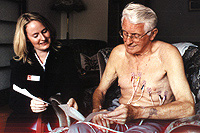|
|
|
Nutrition and Diagnosis-Related
Care
|
|
Cardiac cachexia is a
multifactoral neuroendocrine and metabolic disorder seen in some
patients with severe or end-stage congestive heart failure (CHF). It
carries a poor prognosis.
- The appearance of the typical patient
with CHF can be quite deceiving with regard to nutritional status.

-
They may appear adequately nourished or even
over weight.
- Remember, edema is
essentially water.
Patients with cardiac cachexia suffer
with
- General loss of fatty tissue (energy
reserves)
- Skeletal muscle, and
- Bone tissue (osteoporosis)
- Cachectic CHF patients are weaker and
fatigue more easily than non-cachectic.
- Neuroendocrine and immunological
factors, independent of the degree of heart muscle damage, are
directly linked to
the development of cardiac cachexia.
- Rise in epinephrine, norepinepherine and
cortisol (indicators of stress)
- High serum aldosterone and renin levels,
but
- Low serum sodium
- Raised plasma levels of tumor necrosis
factor-α (TNF-α)
- The extent of body wasting is strongly
correlated the with degree of abnormality of the hormonal and immune
factor (TNF-α).
- Mortality rate can be as high as 50%
over 18 months with cardiac cachexia.
So can we
do anything to help? |
|